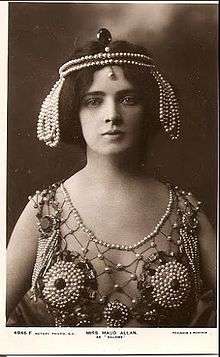Maud Allan
- For the American film actor see Maude Allen.
| Maud Allan | |
|---|---|
 Maud Allan as Salome c. 1906–10. | |
| Born |
Beulah Maude Durrant 27 August 1873 Toronto, Ontario, Canada |
| Died |
7 October 1956 (aged 83) Los Angeles, California, U.S. |
| Nationality | Canadian |
| Known for | Dance and choreography |
| Movement | Modern/contemporary dance |
Maud Allan (27 August 1873 – 7 October 1956) was a pianist-turned-actress, dancer and choreographer who is remembered for her "impressionistic mood settings".
Early life
Allan was born as Beulah Maude Durrant in Toronto, Ontario, Canada. Sources give contradictory dates for her year of birth, ranging from 1873 through 1880. She spent her early years in San Francisco, moving to Germany in 1895 to study piano at the Hochschule für Musik in Berlin. She later changed her name, prompted in part by the scandal surrounding the crimes committed by her brother, Theodore Durrant, who was hanged in 1898 for the murder of two women in San Francisco. Allan never recovered from the trauma of this event. The execution was immediately followed by her abandonment of piano-playing and the development of a new means of self-expression in dance.[1]
Stage and dance career

In 1900, in need of money, Allan is said to have illustrated an encyclopaedia for women titled Illustriertes Konversations-Lexikon der Frau.[2] Shortly thereafter, she began dancing professionally. Although athletic, and having great imagination, she had little formal dance training. She was once compared to professional dancer and legend Isadora Duncan, which greatly enraged her, as she disliked Duncan.[3]
She designed and often sewed her own costumes, which were creative. In 1906 her production Vision of Salomé opened in Vienna. Based loosely on Oscar Wilde's play, Salomé, her version of the Dance of the Seven Veils became famous (and to some notorious) and she was billed as "The Salomé Dancer". Her book My Life and Dancing was published in 1908 and that year she toured England, giving 250 performances in under a year.[3]
In 1910, she left Europe to travel. Over the next five years she visited the United States, Australia, Africa, and Asia. In 1915 she starred as "Demetra" in the silent film, The Rug Maker's Daughter.
Libel suit and later years
In 1918 the British MP Noel Pemberton Billing, in his own journal, Vigilante, published an article, "The Cult of the Clitoris" which implied that Allan, then appearing in her Vision of Salome, was a lesbian associate of German wartime conspirators.
Allan sued Billing for libel, based on the following counts:
- The act of publishing a defamatory article about Maud Allan and J. T. Grein, her impresario.
- The act, a separate offence, of including obscenities within the article.
This led to a sensational court case, at which Billing represented himself. Lord Alfred Douglas also testified in Billing's favour. Allan lost the case. The trial became entangled in obscenity charges brought forth by the state against the performance given by Allan in her dance. She was accused of practising many of the sexually charged acts depicted (or implied) in Wilde's writings herself, including necrophilia. The Lord Chamberlain's ban on public performances of Wilde's play was still in place in England and the Salomé dance was at risk. Her brother's crimes were also cited to suggest there was a background of sexual insanity in her family. From the 1920s, Allan taught dance and lived with her secretary and lover, Verna Aldrich.[3] Allan died in Los Angeles in 1956 aged 83.
Fiction and theatre
Allan's Salomé dance, the reactions to it and its significance in terms of the sexual, social and political mores of the time appear in Pat Barker's 1993 novel The Eye in the Door, the second part of the Regeneration trilogy. Allan's libel suit is the subject of a "fictography", The Maud Allan Affair by Russell James and a stage play Salomania by Mark Jackson, which premiered at the Aurora Theatre in Berkeley, CA in June 2012.[4]
References
- ↑ "Maud Allan". Danse Collection Danse. Archived from the original on 2 March 2005. Retrieved 15 June 2014.
- ↑ Illustriertes Konversations-Lexikon der Frau
- 1 2 3 Rapp, Linda (2002). "Allan, Maud (1873–1956)" (PDF). glbtq encyclopedia. Retrieved 2018-03-24.
- ↑ "Anatomy, war and 'Salomania' at the Aurora Theatre". San Francisco Chronicle. 7 June 2012. Retrieved 15 June 2014.
Further reading
- Philip Hoare, Wilde's Last Stand: Decadence, Conspiracy & The First World War Duckworth, (1997)
- Felix Cherniavsky, Maud Allan and Her Art, Dance Collection Danse Presse (1998)
- Toni Bentley, Sisters of Salome, Yale University Press, 2002
- Wendy Buonaventura, Midnight Rose, Cinnabar Books, 2009
- Russell James: The Maud Allan Affair, Remember When, 2009
External links
| Wikimedia Commons has media related to Maud Allan. |
- Maud Allan on IMDb
- Maud Allan Papers, 1910–1934 (1 linear foot) are housed at the Charles E. Young Research Library at the University of California Los Angeles.
- John Henry Bradley Storrs Papers, 1847–1987 (18.4 linear feet) are housed at the Smithsonian Institution Archives of American Art.
- Works by or about Maud Allan at Internet Archive
- "The Unspeakable Crime of Maud Allen". Cherished Television.
- Maud Allan on streetswing.com
- Maud Allan on Bellydancers and Harem Girls
- Felix Cherniavsky: Maud Allan and Her Art